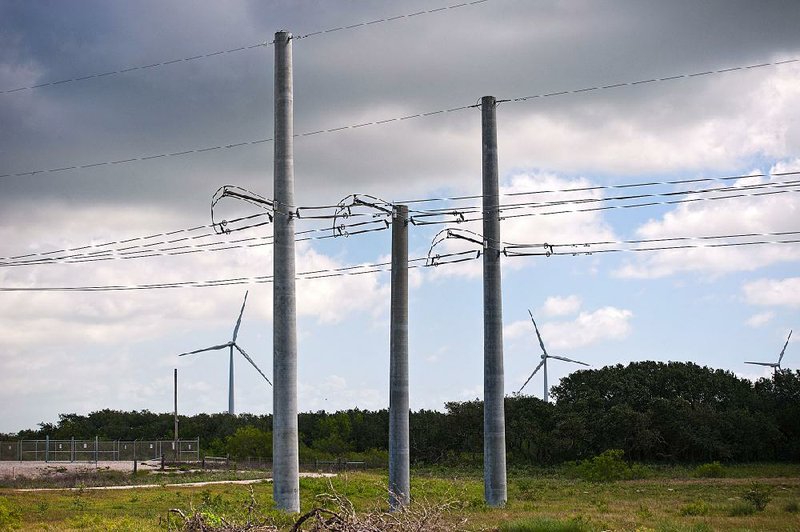ST. LOUIS -- Experts say that building wind farms is the easy part. Far bigger complications arise when it comes to building transmission to distribute the energy produced -- challenges that are on full display in Missouri.
With western-neighbor Plains states teeming with wind energy, and lots of demand for that power in population centers farther east, Missouri straddles a bit of a geographic crossroads with transmission in mind.
Physically linking that supply with demand is never simple because of both logistics and bureaucracy -- as shown by Missouri's continued rejection of the stalled Grain Belt Express transmission line, which would carry wind power from Kansas to Indiana and into the grid beyond.
Some people, including the developers of the proposed project, say the state's failure to approve the line -- and its policies that currently stifle similar infrastructure -- is adding to an already-congested transmission bottleneck that has ripple effects beyond Missouri.
"It's almost the definition of a bottleneck," said Mark Lawlor, vice president with Clean Line Energy Partners, the Houston-based developer of the Grain Belt project. "It's a choke point on the entire system."
Though approved by the three other states along its path, the project has been held up by Missouri regulators invoking a controversial court ruling that says approval must first be given by each individual county along its path. That ruling has been widely criticized -- even by the state regulators themselves -- since it essentially gives county commissioners the ability to disrupt plans for power distribution on a regional, or even broader, scale.
"The context that's unique about Missouri is this issue of county assents," said Scott Rupp, a member of the state Public Service Commission who said he "reluctantly" voted against approving the Grain Belt project in August. "This would be the end of any Missouri-sited transmission in the future."
"It is sort of becoming a Missouri-specific challenge to get these [projects] done," Lawlor added. "Only Missouri is where we have these sort of unique problems."
Clean Line is challenging the ruling, and oral arguments on the matter were held Thursday at the Eastern District of the Missouri Court of Appeals in St. Louis.
But given Missouri's location and the growing demand for ever-cheaper wind power, the Grain Belt Express is likely the first of what would be an emerging trend of prospective transmission projects to be jeopardized -- at least for now -- by Missouri's narrow interpretation of its legal authority to approve them.
"Wind is basically the cheapest form of energy now. It's not like this problem will go away," said Rupp. "We need to look at these things from a regional perspective."
Despite the complication, others say that transmission projects will ultimately find a way to bridge the west-to-east gap with or without Missouri -- threatening to have the state miss out on the benefits, without a fix.
"Certainly from a cost and environmental perspective, it's a problem," said Ashok Gupta, a Kansas City energy economist for the Natural Resources Defense Council. "Everybody wants cheaper electricity for their residents."
Clean Line was also the focus of a letter Arkansas' congressional delegation wrote to U.S. Energy Secretary Rick Perry in January in which they urged him to either "pause or terminate" a proposed Clean Line project that would stretch across north Arkansas.
The $2.5 billion project would have carried wind-generated electricity from the Oklahoma panhandle to Tennessee. The line would span more than 700 miles, entering Arkansas north of Van Buren and exiting the state south of Wilson in Mississippi County.
Transmission challenges aren't new, nor are they unique to a certain part of the nation. But the rise of cheap renewable energy in far-flung parts of the country is creating new -- but tedious -- scrambles to connect it to consumers.
"Whether it's solar in the Southwest or wind in the Plains, building transmission gets that cheap electricity out" to customers, said Aaron Bloom, who manages a team of engineers that looks at national power system planning for the Grid Systems Analysis Group at the U.S. Department of Energy's National Renewable Energy Laboratory in Colorado.
"There's quite a bit of value in joining together," said Bloom. "It lowers the cost of serving our electricity demand and it increases the reliability."
One of Bloom's projects looks at bridging perhaps the biggest "seam" in the grid: the divide between the Eastern and Western halves of the country, which essentially operate on independent grids on either side of the Rocky Mountains.
He says Grain Belt looks to address similar issues, though on more of a regional scale.
"What should we think about joining the two systems together in sort of a more coordinated national system?" Bloom asked. "Grain Belt is one of those projects that's sort of asking similar questions."
But as is the case in Missouri, he adds that "the stumbling block always becomes the institutions."
Not only do Missouri customers miss out on millions in anticipated cost savings according to the state's Public Service Commission, but Bloom says the lack of wind-friendly transmission will complicate corporate or municipal goals to shift to renewable energy.
"I wouldn't say they're making the problem or missing the boat necessarily, but there is an opportunity here to make their goals easier," Bloom said.
St. Louis aldermen, for instance, recently passed a resolution aiming for the city to use 100 percent clean energy by 2035.
"Thinking about your goals and how this transmission can get you there is probably a reasonable thing to be doing," said Bloom. "If I was St. Louis ... and my mayor was talking about 100 percent, I'd be very interested in hearing more about that transmission and how we could work together."
The same applies to businesses.
A report released last month by the Wind Energy Foundation concluded that more transmission is needed to meet corporations' growing demand for low-cost renewables.
Business on 02/14/2018

